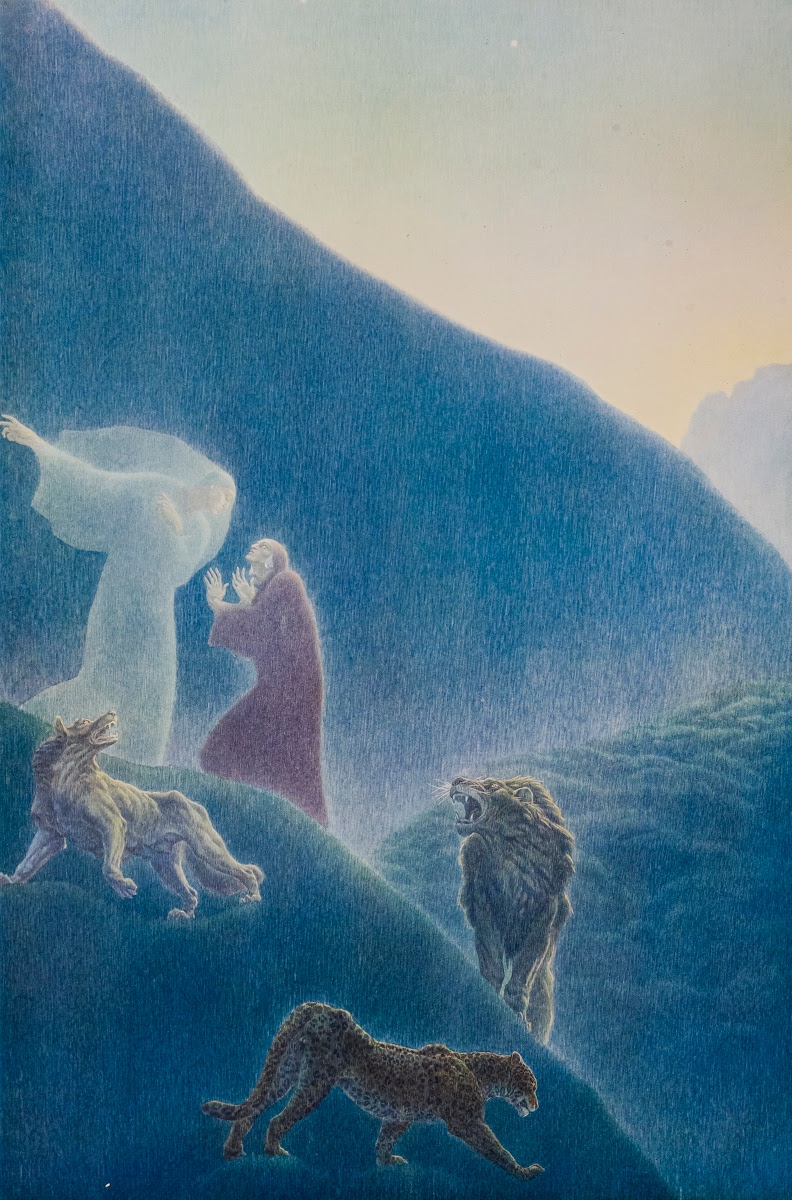Monaramis’s depictions of Dante Alighieri’s Inferno feature an array of muted colors that stem from an earthy palette. These are layered over the black contour of the scene (which appears to have been drawn by hand). The composition focuses on Cerberus as it imposes over a historical monument, seemingly intent to sniff out the two figures hiding in the foreground. The line-work of this piece is sketchy and heavily gestural, which reinforces the dynamism of the Canto depicted. — Monaramis Art, “Dante’s Inferno— La Divina Commedia,” Behance, 2015 (Retrieved March 28, 2024).
Amos Nattini’s Illustrations of The Divine Comedy (1900s)
“Many artists have interpreted Dante’s afterlife by letting themselves be inspired by the culture and fears of their time. Amos Nattini, between 1915 and 1939, undertakes this great project with passion and dedication, giving us an absolutely human and realistic version of it. His lithographs were published together with the Divine Comedy text in three volumes. The edition of the Cariparma Foundation is dated 1939.” — “Amos Nattini and The Divine Comedy,” Google Arts and Culture, 1900s (Retrieved March 28, 2024).
Wilhelm Lehmbruck’s Paolo and Francesca (1910s)
German artist Wilhelm Lehmbruck (1881-1919) created a depiction of Paolo Malatesta and Francesca Da Rimini, two real-life individuals featured in Dante’s Inferno for engaging in an adulterous relationship. The artist, using drypoint, depicts the affection of the two forbidden lovers in a sketchy and gestural manner that is enriched by the stark, geometrical line-work. — Wilhelm Lehmbruck, “Paolo and Francesca,” Princeton University Art Museum, 1910s (Retrieved March 28, 2024).
Paul Laffoley’s Dantean Triptych (1972-1975)
“Paul Laffoley’s extraordinary triptych of Dante’s Comedy brings Dante’s ‘altro dove’ (literally, ‘other where’) into a remarkably comprehensive and vivid translation. In the history of illustrations of the Comedy, there is nothing like it. Laffoley is the only artist, as far as I know, to have depicted all one hundred cantos and the topography of Hell, Purgatory, and Paradise, in the same piece.
“With the classical, religious, mathematical, esoteric, and cosmo-logical themes present in Laffoley’s opus, Dante’s Comedy was a natural text for him to turn his attention. The Divine Comedy triptych, 1972-75 (plates 29, 30, and 31), indubitably bares his trademarks of architectonic precision, mind-boggling detail, immense erudition, symmetry, balance, and the word-techniques that lend themselves to an illustration of something as vast, multidimensional, intricate, and based in language and interpretation as Dante’s Comedy.” — Arielle Saiber, “Laffoley and Dante’s Other Worlds,” in The Essential Paul Laffoley, ed. Doug Walla (2016), 23-29.
The Divine Comedy Illustrated by Mimmo Paladino (2021)
“Sergio Risaliti, director of the Museo Novecento in Florence and curator of the contemporary art section at the Museo e Real Bosco di Capodimonte in Naples, has seized on the importance of the anniversary to devise an ambitious project: a special edition of The Divine Comedy illustrated by artist Mimmo Paladino. The volume, published by Forma Edizioni, is enriched with essays by Cristina Acidini and Giorgio Bacci, as well as boasting the collaboration of Riccardo Bruscagli, an expert on Dante and professor emeritus of Italian literature at the University of Florence.
[…]
“How do the images connect with the words? What do they want to give back to the reader?
“Dante is a plastic and figurative poet; we could call him, today, a contemporary film director. In the Divine Comedy there are very powerful images that return a strong visual impact. We think of Paolo and Francesca, so overwhelmed by their love, embraced and entwined allinfinity, here Dante was writing making images alive. Paladino, taking his cue from Dante’s immense figurative repertoire, brings with his illustrations other solicitations, going beyond the limit of words and adding his portion of space and meaning.” — Antonio Mirabelli, “The Divine Comedy illustrated by Mimmo Paladino. Interview with the creator, Sergio Risaliti”, Finestre sull’Arte, March 23rd, 2021.
- 1
- 2
- 3
- …
- 8
- Next Page »





